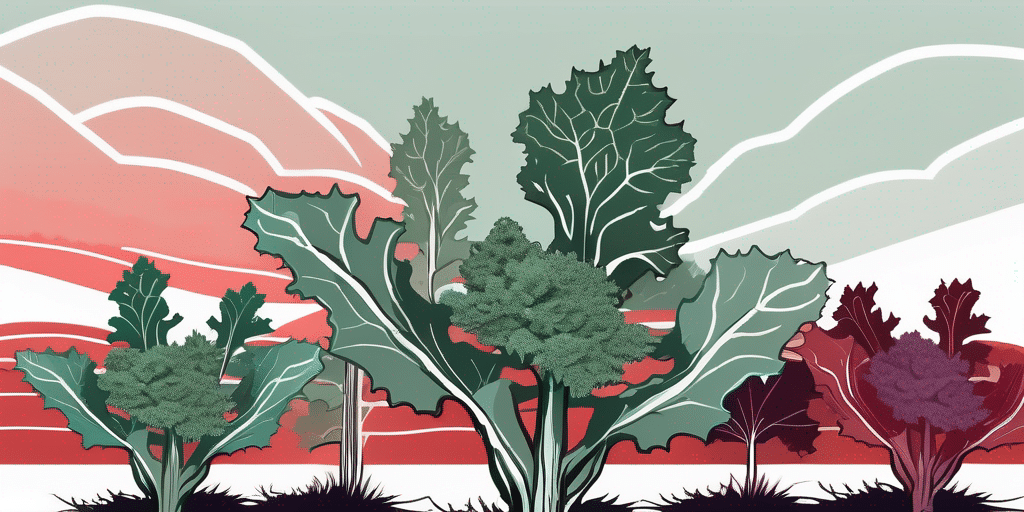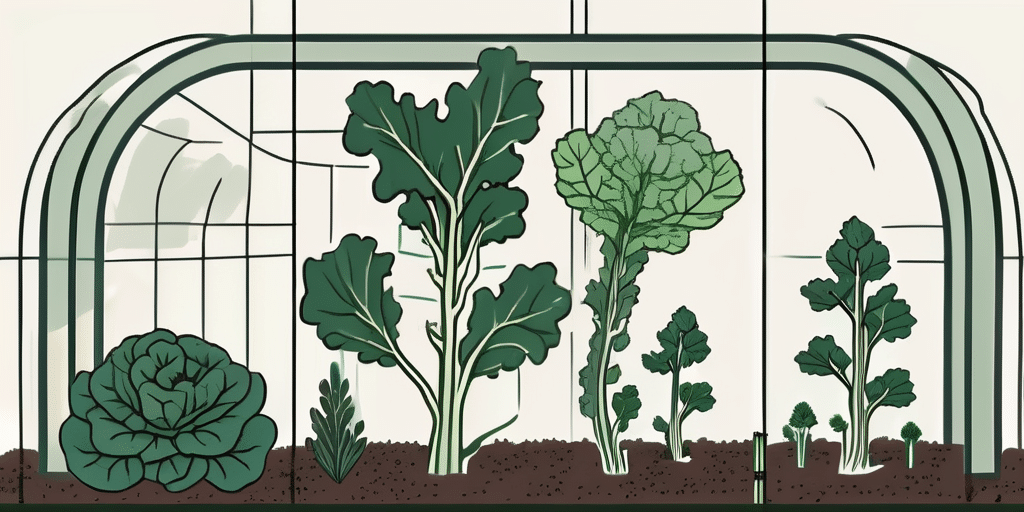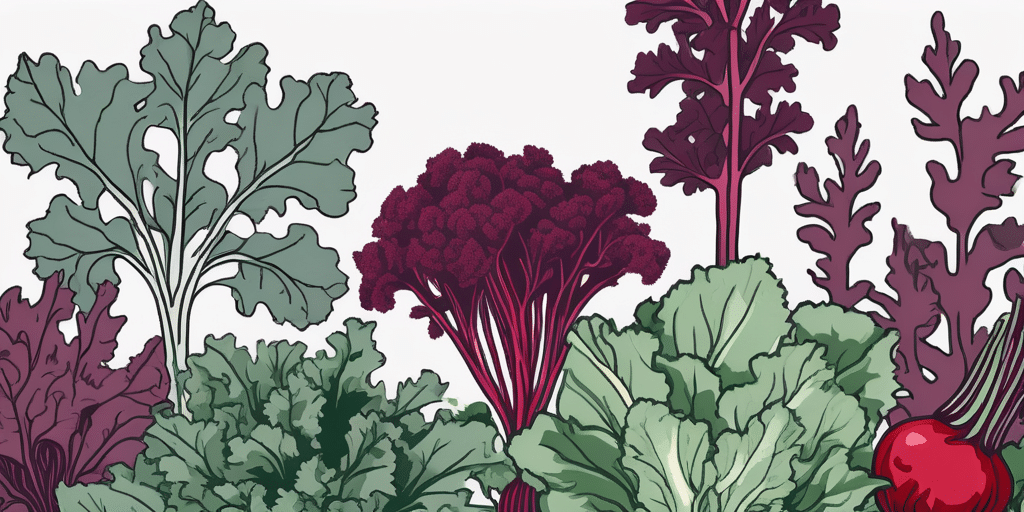In the world of leafy greens, kale stands tall as a nutritional powerhouse. With its vibrant colors and hearty texture, kale has taken the culinary world by storm. But did you know that not all kale is created equal? In this article, we will compare two popular varieties: Vates Kale and White Russian Kale. Let’s dive in and explore the characteristics, pros, and cons of each to help you make an informed decision about which one is right for you.
What is Vates Kale?
Vates Kale, also known as Winterbor Kale, is a variety of kale that belongs to the Brassica family. It has dark green, curly leaves that are packed with nutrients. This variety is often referred to as “dinosaur kale” due to its bumpy texture, reminiscent of dinosaur skin.
Vates Kale has gained popularity for its rich flavor and versatility in cooking. Whether you prefer it raw in salads or cooked in soups and stir-fries, Vates Kale can add a nutritional punch to any dish.
One interesting fact about Vates Kale is its high concentration of vitamins and minerals, making it a superfood in the world of leafy greens. It is particularly rich in vitamin K, vitamin C, and beta-carotene, all of which contribute to a healthy immune system and glowing skin.
Another noteworthy characteristic of Vates Kale is its adaptability to various climates, making it a resilient crop for farmers around the world. This kale variety can thrive in both cool and warm temperatures, allowing for year-round cultivation in different regions.
Pros & Cons of Vates Kale
Like any vegetable, Vates Kale has its pros and cons. Let’s take a closer look at what makes this variety a great choice:
Vates Kale, also known as Scotch Kale or Winterbor Kale, is a nutritional powerhouse that offers a wide array of health benefits. Packed with vitamins A, C, and K, as well as essential minerals like calcium, iron, and fiber, this leafy green is a fantastic addition to any diet. Its high antioxidant content helps boost the immune system and promote overall well-being.
- Nutritional powerhouse: Vates Kale is packed with vitamins A, C, and K, as well as calcium, iron, and fiber.
- Cooking versatility: Its sturdy leaves hold up well in cooking, making it a great choice for sautés, stews, and smoothies.
- Long harvest period: Vates Kale is a cold-hardy variety, allowing for harvest well into late fall and early winter.
Despite its many benefits, Vates Kale does have a few downsides to consider:
While Vates Kale is a beloved vegetable for many, some individuals may find its taste to be slightly bitter, especially when consumed raw. However, there are various ways to combat this bitterness, such as incorporating sweet or acidic ingredients into dishes featuring Vates Kale.
- Bitter taste: Some people find Vates Kale to have a slightly bitter taste, especially when eaten raw. Cooking methods like blanching or massaging with olive oil can help mitigate this bitterness.
- Tough texture: The curly leaves of Vates Kale can be tough and fibrous, requiring longer cooking times or tenderizing techniques like marinating or massaging.
Overall, Vates Kale is a versatile and nutritious vegetable that can be enjoyed in a variety of dishes, providing both flavor and health benefits to those who incorporate it into their diet.
What is White Russian Kale?
White Russian Kale, also known as White Kale or Siberian Kale, is another popular variety in the kale family. As the name suggests, White Russian Kale has smooth, flat leaves that are a light green hue. This variety is known for its delicate texture and mild flavor, making it a favorite among kale enthusiasts.
White Russian Kale is an excellent choice for those who prefer a milder taste and a more tender texture.
Pros & Cons of White Russian Kale
Let’s explore the benefits of adding White Russian Kale to your diet:
- Delicate flavor: White Russian Kale has a milder taste compared to other kale varieties, making it a great option for those who find kale too bitter or overpowering.
- Tender texture: The smooth leaves of White Russian Kale require less cooking time, making it a versatile option for quick stir-fries and salads.
- Abundant vitamins and minerals: Similar to Vates Kale, White Russian Kale is packed with nutrients, including vitamins A, C, and K, calcium, iron, and fiber.
However, it’s important to consider the following drawbacks when choosing White Russian Kale:
- Shorter harvest period: White Russian Kale is a less cold-hardy variety, meaning it has a shorter growing season and may not tolerate freezing temperatures as well as Vates Kale.
- Slightly higher cost: Due to its popularity and delicate nature, White Russian Kale can sometimes be more expensive compared to other kale varieties.
Is Vates Kale or White Russian Kale Right for You?
Now that we’ve explored the characteristics, pros, and cons of Vates Kale and White Russian Kale, it’s time to determine which one is the right choice for you.
If you love the hearty texture and rich flavor of kale, Vates Kale might be the ideal variety for you. It’s perfect for those who enjoy cooking and experimenting with different recipes.
On the other hand, if you prefer a milder taste and a more delicate texture, White Russian Kale is worth considering. Its tender leaves and versatile nature make it a great choice for incorporating into salads and lighter dishes.
Ultimately, the choice between Vates Kale and White Russian Kale comes down to personal preference and the specific recipes you have in mind. Feel free to experiment with both varieties and see which one resonates with your taste buds the most!
Frequently Asked Questions
Here are some common questions and answers about Vates Kale and White Russian Kale:
- How do I store kale?
- Remove any rubber bands or ties around the kale bunch.
- Rinse the leaves thoroughly to remove any dirt or debris.
- Wrap the kale loosely in a damp paper towel.
- Place the wrapped kale in a plastic bag or container with a lid.
- Store the kale in the refrigerator for up to 1 week.
- Can I freeze kale?
Yes, kale can be frozen for later use. Follow these steps to freeze kale:
- Wash the kale leaves and remove any tough stems.
- Blanch the leaves in boiling water for 2 minutes, then transfer them to an ice bath to stop the cooking process.
- Drain the kale and pat it dry with a paper towel.
- Place the kale in a freezer-safe bag or container, removing as much air as possible.
- Label the bag with the date and store it in the freezer for up to 8 months.
- Are there any health risks associated with kale consumption?
While kale is generally considered safe for consumption, it contains compounds called oxalates that may interfere with calcium absorption in some individuals. If you have a history of kidney stones or other related conditions, it’s best to consult with a healthcare professional before significantly increasing your kale intake.
Now armed with knowledge about Vates Kale and White Russian Kale, you can confidently add these nutritious leafy greens to your culinary repertoire. Whether you choose the sturdy textured leaves of Vates Kale or the delicate, mild flavor of White Russian Kale, both varieties offer a myriad of health benefits and culinary opportunities. Happy cooking!
Join How to Grow Everything for More Green Thumb Secrets!
Ready to transform your culinary garden into a verdant oasis of nutrition? At How to Grow Everything, we’re committed to helping you cultivate the garden of your dreams. Subscribe now for free and get personalized gardening advice tailored to your grow zone, experience, and interests. No spam, just the best gardening tips and exclusive deals, straight to your inbox. From our family to yours, let’s grow together. Subscribe for free today and start your journey to a bountiful harvest!






